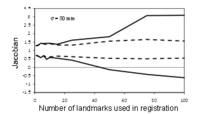Difference between revisions of "2011 Winter Project Week:LandmarkRegularization"
| Line 3: | Line 3: | ||
Image:PW-SLC2011.png|[[2011_Winter_Project_Week#Projects|Projects List]] | Image:PW-SLC2011.png|[[2011_Winter_Project_Week#Projects|Projects List]] | ||
Image:genuFAp.jpg|Scatter plot of the original FA data through the genu of the corpus callosum of a normal brain. | Image:genuFAp.jpg|Scatter plot of the original FA data through the genu of the corpus callosum of a normal brain. | ||
| − | [[File:Jac_wiki.png|200 px|Minimum and maximum values of the Jacobian of the test-to-reference image transformation as function of the number of landmark pairs used for RBF field calculations. Solid lines are the results for registration without regularization, dashed lines are for registration with regularization. ]] | + | Image:Jac_wiki.png|[[File:Jac_wiki.png|200 px|Minimum and maximum values of the Jacobian of the test-to-reference image transformation as function of the number of landmark pairs used for RBF field calculations. Solid lines are the results for registration without regularization, dashed lines are for registration with regularization. ]] |
</gallery> | </gallery> | ||
Revision as of 17:36, 17 December 2010
Home < 2011 Winter Project Week:LandmarkRegularizationKey Investigators
- MGH: Nadya Shusharina, Gregory Sharp
Objective
We are introducing a new approach for landmark-based deformable image registration. Our method uses Gaussian radial basis functions (RBFs) to define a vector field from point landmarks, and applies regularization based on the vector field second order derivative.
Approach, Plan
Our approach is based on the fact that the Gaussian RBF has infinite support, but the influence of each RBF is localized, making this method well suited for local corrections. In addition, Gaussian RBFs have a distinct advantage over competing approaches such as Wendland functions, because the regularized vector field can be solved exactly with a simple equation. Our plan for the project week is to implement our registration algorithm as a Slicer plugin.
Progress
Algorithm for the landmark-based registration has has been implemented as a part of out in-house software Plastimatch. The method has been validated on a large landmark sets available for download on DIR-LAB web site. This work has been submitted for publication to IEEE Transactions on Medical Imaging.
Delivery Mechanism
This work will be delivered to the NA-MIC Kit as a (please select the appropriate options by noting YES against them below)
- ITK Module
- Slicer Module
- Built-in
- Extension -- commandline YES
- Extension -- loadable
- Other (Please specify)
References
- DIR-LAB. http://www.dir-lab.com
- Plastimatch. http://plastimatch.org



